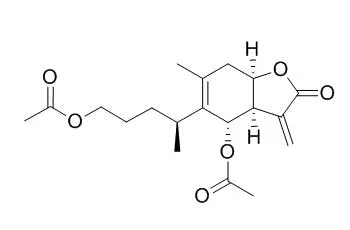| In vitro: |
| Inflammation. 2017 Dec;40(6):1967-1974 | | 1,6-O,O-Diacetylbritannilactone Inhibits Eotaxin-1 and ALOX15 Expression Through Inactivation of STAT6 in A549 Cells.[Pubmed: 28770377] | 1,6-O,O-Diacetylbritannilactone (OODBL), a plant sesquiterpene lactone, was previously reported to show multiple pharmacological effects such as anti-cancer and anti-inflammatory activities.
METHODS AND RESULTS:
In this study, we investigated the anti-inflammatory effect of OODBL on interleukin (IL)-4-induced signal transducer and activator of transcription 6 (STAT6) signaling pathway in human lung A549 cells. We found that OODBL dramatically inhibited IL-4-induced messenger RNA (mRNA) expression of eotaxin-1 and arachidonate 15-lipoxygenase-1 (ALOX15) in a dose-dependent manner. To clarify the action mechanism of OODBL, we examined the effect of OODBL on activation of STAT6. OODBL decreased both STAT6 phosphorylation and reporter gene activity. Furthermore, OODBL suppressed phosphorylation of Janus Kinase 3 (JAK3) without affecting JAK1.
CONCLUSIONS:
Taken together, OODBL abolished IL-4-induced eotaxin-1 and ALOX15 mRNA expressions by repressing the activation of STAT6 and JAK3. These results suggest that OODBL has a potential therapeutic efficacy on inflammatory diseases especially allergic airway disease as a lead compound. | | Nat Prod Commun. 2016 Jan;11(1):7-10. | | Cytotoxic and Pro-apoptotic Activities of Sesquiterpene Lactones from Inula britannica.[Pubmed: 26996005] |
METHODS AND RESULTS:
In this study, five known sesquiterpene lactones (STL) with an α-methylene-γ-lactone motif, including two eudesmanolides, 1β-hydroxyalantolactone (1) and ivangustin (2), and three 1,10-seco-eudesmanolides, 1-O-acetylbritannilactone (3), 1,6-O,O-Diacetylbritannilactone (4), and 6α-O-(2- methylbutyryl)britannilactone (5) were isolated from the flower heads of the medicinal plant Inula britannica.
Their structures were characterized by spectroscopic methods. X-ray data of 2 is reported for the first time.
CONCLUSIONS:
Among them, eudesmanolides 1 and 2 exhibited remarkable cytotoxicity against HEp2, SGC-7901 and HCT116 human cancer cell lines, comparable with etoposide (Vp-16) used as reference drug. Furthermore, treatment of HEp2 cells with 1 induced apoptosis associated with cleaved procaspase-3 and PARP.
The biological assays carried out with normal cells (CHO) revealed that all sesquiterpenes were weakly selective against the cancer cell lines tested. |
|






 Cell. 2018 Jan 11;172(1-2):249-261.e12. doi: 10.1016/j.cell.2017.12.019.IF=36.216(2019)
Cell. 2018 Jan 11;172(1-2):249-261.e12. doi: 10.1016/j.cell.2017.12.019.IF=36.216(2019) Cell Metab. 2020 Mar 3;31(3):534-548.e5. doi: 10.1016/j.cmet.2020.01.002.IF=22.415(2019)
Cell Metab. 2020 Mar 3;31(3):534-548.e5. doi: 10.1016/j.cmet.2020.01.002.IF=22.415(2019) Mol Cell. 2017 Nov 16;68(4):673-685.e6. doi: 10.1016/j.molcel.2017.10.022.IF=14.548(2019)
Mol Cell. 2017 Nov 16;68(4):673-685.e6. doi: 10.1016/j.molcel.2017.10.022.IF=14.548(2019)